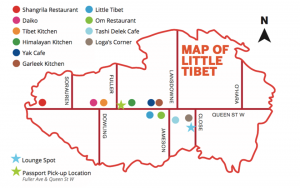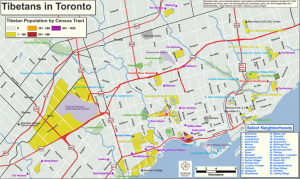After some initial explorations of ethnic landscapes in Toronto’s inner city, I settled on Little Tibet, an ethnic enclave within the Parkdale neighbourhood of the city. The boundaries of this neighbourhood have been defined in various ways by the Parkdale Business Improvement Association and by journalists of grey literature. I have chosen to use the boundaries of Dufferin Street to Sorauren Street along Queen Street West to delineate the enclave. I have chosen these boundaries because this is where the majority of the Tibetan people live, as seen in Figure 1, and Tibetan restaurants are located, as seen in Figure 2.
The three blog posts I have written will explore three elements of diversity seen in Little Tibet’s ethnic landscape: ethnic, political and religious diversity. In this first post, I will examine how Little Tibet’s institutions, events and services have served to manifest ethnicity in the landscape. In the second, which examines the religious and political diversity of the neighbourhood, I will look at how religion and politics have contributed to Little Tibet’s physical and symbolic form. I will end with the changes occurring in Little Tibet and the implications of the changes on the enclave’s future. I will argue throughout that the various institutions in Little Tibet support ethnic, religious and political diversity of the Tibetan people must be maintained if the enclave is to survive in the future.
Little Tibet is an ethnic enclave, which Qadeer notes is “a residential cluster of a particular ethnic group that has built a community life through developing institutions, businesses and services” (2016). In the last decade more than 3,000 Tibetans have moved to Toronto, of which 56% have settled in Parkdale (The Star, 2008). Little Tibet is an anomaly in the context of Toronto’s ethnic enclaves due to its steady immigration of Tibetans. These days it is typical for immigrants to Toronto to move into newer enclaves in the suburbs such as Richmond Hill or Agincourt, while immigration to inner city enclaves has slowed. It’s important to note that Tibetans have chosen to settle in Little Tibet, rather than being forced there by systematic discrimination. This is what makes Little Tibet an ethnic enclave rather than a ghetto.
When immigrants settle in an area, they are attracted by the existing community life which Qadeer notes characterize ethnic enclaves. Institutions, events and services being offered in the Tibetan language draw Tibetans to this neighbourhood. Little Tibet is located within the High Park-Parkdale federal electoral district. 2% of the residents living in High Park-Parkdale speak a Tibetan language (City of Toronto, 2018). This may seem like a small percentage but given how many language options there are on the Canadian census, it reflects the high number of Tibetans living in this district. Language is important in shaping the feeling of an enclave. On each of my visits to Little Tibet I heard people having conversations in Tibetan and a sense that people were greeting each other even if they didn’t know each other well. This gave me, as a visitor to the enclave, a feeling that this is a strong community of people who are connected, rather than isolated.
Another important draw for Tibetans to Little Tibet is how the institutions in the enclave have accommodated them. Quadeer explains that one way that the multicultural city can be defined is when diverse community cultures are recognized and accommodated by institutions and are part of the city’s geographies (Qadeer, 2016). In my next post I will explore the various ways in which institutions accommodate Tibetans in this enclave.

Figure 1 – A map of Tibetan restaurants
located in Little Tibet (for a larger version, click here)

Figure 2- A map of where Tibetans reside in Toronto (for a larger version, click here)
List of Figures:
Figure 1: The Joshua Project. (2019). Tibetans in Toronto [Image]. Retrieved from https://joshuaproject.net/assets/media/profiles/maps/m15468_ca.pdf
Figure 2: Parkdale Village BIA. (2018). Momo Crawl [Image]. Retrieved from https://parkdalevillagebia.com/wpcontent/uploads/36948590_10160519844280463_639160686345191424_n.png
References:
City of Toronto. (2018). City of Toronto Ward Profiles, Ward 4: Parkdale- High Park. Toronto: City of Toronto, https://www.toronto.ca/wp-content/uploads/2018/09/8f6b-City_Planning_2016_Census_Profile_2018_25Wards_Ward04.pdf.
Qadeer, M. (2016). Multicultural Cities. Toronto: University of Toronto Press.
Qadeer, M. (2016). Multicultural Cities. Toronto: University of Toronto Press.
